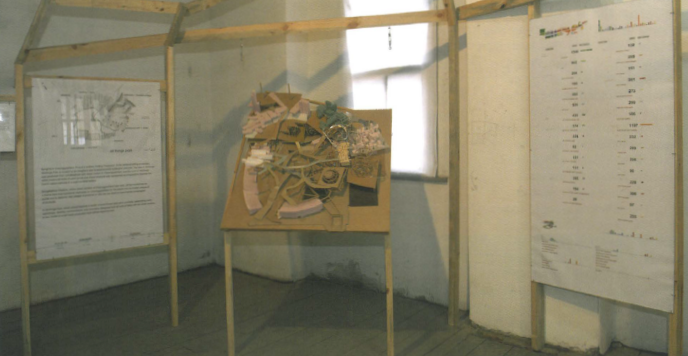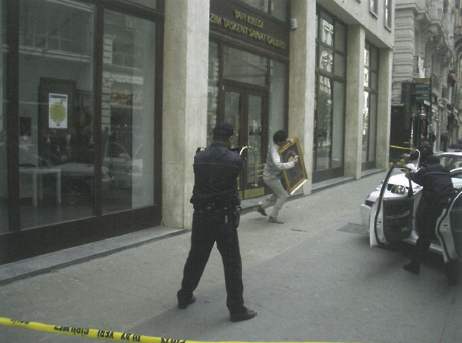
Istanbul is wonderful, especially when a major contemporary art event – the 2005 9th International Istanbul Biennial - complements Ottoman glories, the odd bit of 5th century Christian Emperor Justinian, eponymous baths, acres of bazaar, and an elegant gloss on life.
Biennial facts
Dates: 16 September - 30 October – the shortest biennial in the world?
Site: Away from the seductions of Hagia Sofia or the Topkapi and housed in six existing buildings in the mainly century-old parts of Beyoglu, a sector of Istanbul on the hilly finger of land north of the Golden Horn, still on the European side of the city and sporting ostentatious stone facades of burgher mansions reminiscent of Manchester or Collins St or every Eastern European city nearby. The sites ranged from a large customs warehouse (the least successful venue), to a small 17th Century warehouse still smelling of tobacco, and on to two crumbling old apartment buildings, a shop front, and two new unfinished buildings. All were marked by Gruppo 12's 'magenta' (we said pink and were frowned on) painted facades, doors and windows.
Curators: Charles Esche and Vasif Kortun
Artists: 53, and of those we chose 16 highlights and of them four were from the Balkans, four from the Middle East, four from Western Europe, and four 'others' – from Mexico, Korea, Indonesia and one Istanbul. Nine of our 16 were born in the 1970s, i.e. in their 30s. That's a flavour of the flavour.
Audience: entirely unscientifically, it was overwhelmingly Istanbulis enthusiastically climbing stairs, looking and discussing with maps in hand, plus a sprinkling of others like us.
Guides: a no-frills ($25 got entry and the 300 page guide) b x w (and magenta), user-friendly, very informative catalogue that everyone carried and used, in English and Turkish, and a map.

And the show itself:
The curatorial premise was the site. The curators' opening sentence in the catalogue is 'This biennial is for and about Istanbul.' We haven't seen a major exhibition like this so successfully address a place in such a clear but uninsistent way. Istanbul was presented first as a physical place: Third World, Islamic, bridging southern Europe and 'Asia', and as a contrast to northern Europe. The second representation of the city was as central to a region, with its focus on artists from the Eastern Mediterranean, the Levant, the Balkans, Egypt and Turkey. Others from outside this region gravitated to this, reacted to it or stood in contradistinction to it. The third representation was the focus on the political, social and (built) environment of such a place. This was made very relevant, fresh and immediate by the number of site-specific pieces by artists coming to make work especially for the biennial. As is the nature of major exhibitions, often the younger artists are willing and able to spend the time and focus on a project like this, as was reflected by the ages and the newer international profiles of most those involved.
The selection of artists was plausible, varied and engaged. Site-specific installations varied from the lightest of often humorous interventions to highly elaborate and slick (and expensive) presentations. The curatorial hand was obvious but not overbearing.
Any sense of deja-vu – what art events do not give this? – probably came from familiarity with mostly mainstream methods on display rather than actual objects themselves. The idea that the artists had fully engaged with Istanbul meant that most artworks were neither re-cycled nor drained of life.
The physicality of this focus on a place is not easily accessed by most of us. Its specificity led to understandings not possible to gain elsewhere and delight in experiencing it. It was the thrill of theatre over film, a meeting over email, physical magic over distanced, manipulated virtuality.
Some marvellous works:
Halil Altindere – video of Beyoglu's main street with imaginary disruptions that pay tribute to the power of street life as more interesting than art, Yael Bartana – film of a children's game that presents aggressors breaking up a seemingly coalescent group, Johanna Billing – film of Croatian children presenting a study of memory and adaptation, Michael Blum – engaging documentary installation that messed with fact/fiction boundaries, Flying City – architectural model addressing the social issues studiously downplayed by capital development, Jakup Ferri – includes a very funny and pertinent video of the artist like a petulant child pretending to break into a John &Yoko recording, Daniel Guzman – lively videos shot in the street and a park suggesting that being out and about is full of possibilities, Servet Kocyigit – a Turkish housewife's whisking, winking objects of daily rituals meet the Sorcerer's Apprentice, Yaron Leshem – a seductive light box panorama that presenting with Israeli Defence Force training methods for fighting in Palestinian villages, David Malikovic - video of a wondrous-mysterious visit to a memorial park without qualities, Ola Pehrson – Hunt for the Unabomber presents as a sharp little school project with a clear social context, Khalil Rabah –museum style presentation with olive tree products as symbolic of the natural world versus our chosen cultural imperatives, Nedko Solakov – vacated apartment developing its own personality and making wry observations, Wael Shawky – impeccable 'supermarket' recital of the Koran, Pilvi Takala – northern woman disrupts Turkish men's routine in the coffee houses, reminiscent of the Women's Movement, Tintin Wulia – Everything's OK - engaging video presenting the impossibility of both speedy and organised urban development.
After taste – conclusion.
It is difficult not to compare Istanbul with the Venice Biennale. Venice presents a spectacle of artworks that are more self-sufficient, grander and mostly more established. Istanbul may have been the seat of the Sublime Porte but Turkey has not yet become a country that gives the world infallibility.
Turkey's current chances with the EU are a reminder to Australians of our own curious long distance cultural arrangements with Britain and Europe. The Biennial art spoke of Istanbul and the artist's place in the world and in doing so reminded us of our own.












